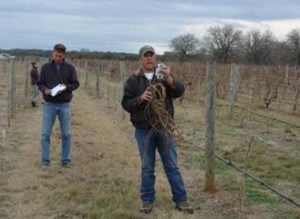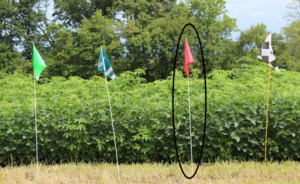By Jim Kamas (February 2018)
Grapevines vary in their ability to withstand cold winter temperatures, but in Texas, weather conditions preceding any freeze event typically have more to do with bud and vine survival than the cold hardiness of the variety itself. The process of vine acclimation for the next winter actually starts with the shortening of day length after the summer solstice. As the days shorten, vines start to form periderm on current season’s growth and decelerate the rate of vegetative growth. In late summer and fall, healthy vines continue to photosynthesize and store carbohydrates in buds, roots, trunks and canes. This late season carbohydrate loading is important in maximizing the hardiness of grapevines. This is why it is important that water not be cut off following harvest as it is needed to maintain the canopy and photosynthetic action necessary for this carbohydrate formation. As temperatures cool through autumn, leaves begin to senesce and fall with the first hard frost or freeze.
With the onset of winter and falling temperatures, vines go deeper into rest and reach their ultimate hardiness where they are capable of withstanding temperatures into the teens and even single digits. Not all grape varieties enter dormancy at the same time. ‘Cabernet-Sauvignon’, for example, is a late acclimater and can be injured by early hard freezes in autumn when other varieties receive no injury at all. There are relative degrees of ultimate hardiness among varieties, so in some locations, that hardiness or lack of hardiness needs to be a part of the decision whether a variety gets planted or not.
Grapevines acclimate very slowly, but they deacclimate very rapidly. Unseasonably warm periods in January and February can cause vines to quickly begin to deacclimate making them susceptible to injury at temperatures they could have withstood before the warm weather. Whether it’s very low temperatures themselves or a hard freeze after vines have deacclimated, cold injury can occur on buds, canes, cordons and trunks. Identifying this injury early can help a grower take appropriate measures to minimize the financial impact and take appropriate corrective measures.
Acute winter injury can be observed early in the season when buds fail to force and vines respond with a flush of suckers from the trunk or ground. At this point a grower should realize that the crop has been badly damaged and even if some primary or secondary buds were not killed, the vascular tissue of the vine has been so badly harmed that it cannot support a canopy through the high transpiration of rates of mid-summer.
Internal inspection of the vascular tissue can confirm that vines have been damaged, but the browning of internal tissue may only be visible after a period of warming temperatures after the freeze event. If vines have been severely damaged, growers should consider retaining three or four suckers and train them up and on to the cordon wire to replace the existing trunk and cordons. Only leaving one or two will most likely result in replacement canes with excessive vigor (bull canes) that will have limited fruitfulness and most likely be cold tender in the following winter.
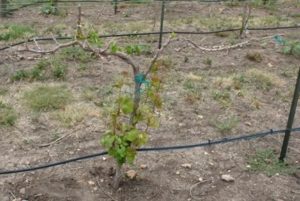
Severely damaged grapevine forcing suckers in mid-spring
More subtle injury in some ways is much more difficult to identify and manage. Buds may force, but stunted vegetative growth typically means there is damage to the “plumbing” somewhere, either on the cordon or trunk. In other cases, vines appear to force and set fruit normally, but collapse during the heat of summer when the compromised vascular system can no longer transport enough water to support the canopy it has produced. In these cases, growers thinking that there was no problem commonly remove suckers in spring which will limit the ability to generate new shoots for vine reconstruction.
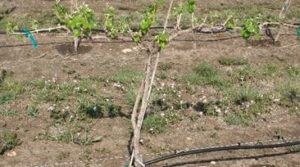
In some situations, stunted shoot growth can signify cold injury
In years like this one where mid-January temperatures were in single digits in much of the state, cold injury may have ocurred in some vineyards. Even though temperatures preceding this cold spell were not warm and vines should have been well acclimated, growers might consider pealing back small patches of bark to look at the vascular tissue.
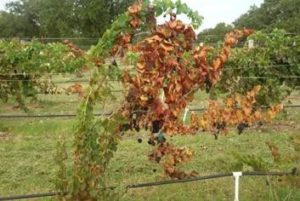
In some seasons, damage to vascular tissue can only be seen after vines collapse in the heat of summer
Brown or grey coloration indicates injury while healthy tissue is bright green. Because of preferential heating of tissue by direct sunlight, southern and western parts of vines can be more quickly deacclimated and are commonly more prone to injury than the north side of the vine. With serious trunk and cordon injury, re-training vines is a necessary task to return the vineyard to productive status. There is really no hurry to cut out freeze injured tissue on injured trunks. Let the vines force and reveal exactly how profound the injury is. If there are a dozen or more competing shoots, selectively thin them out in summer, but remember summer pruning is a dwarfing action and removing a third or more of the vines vegetative tissue will most likely stunt the vine and stop growth.
Winter injury can also cause trunk splitting and can provide entry wounds for crown gall or trigger gall formation in vines already infected with Agrobacterium.
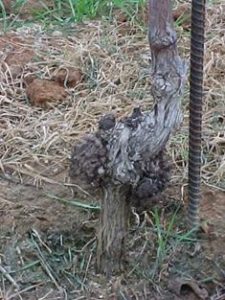
Galling of grapevine trunks from Crown Gall infection
In some years, cold temperatures may not be low enough to cause injury to the vine’s primary structure, but primary fruiting buds may have been killed or injured. Purists would object to the use of the term “bud”, because on grapevines, everywhere a leaf is attached on a shoot is actually called a node, which has three buds. The primary bud is the most fruitful and is why growers refer to leaving a given number of buds per vine after pruning. In addition, each node has a secondary bud which can be somewhat fruitful and a tertiary bud which is not fruitful. Growers typically depend on surviving primary buds to produce the coming season’s crop and plan their pruning programs to leave the appropriate number of nodes to produce a crop at a target tonnage. Cold events that cause primary bud loss commonly affect yield the following growing season. If growers know an approximate level of damage, they can adjust their pruning practices to compensate for the loss. With a very damaging freeze, or after a spring frost takes out primary shoots, secondary buds can force and produce a partial crop. In years with potential damaging events, growers should consider cutting dormant canes of each variety for examination. Bright green coloration indicates healthy buds while killed or injured buds take on a brown or blackish hue. Knowledge of bud survival can help growers make final pruning decisions that may include leaving more “buds” up than average to compensate for primary bud loss due to freeze.
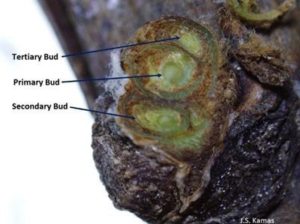
Using a razor blade or other sharp knife, growers can cut and examine grape buds to assess damage
